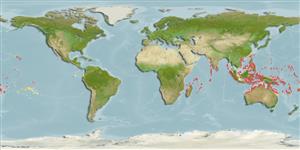>
Ovalentaria/misc (Various families in series Ovalentaria) >
Pseudochromidae (Dottybacks) > Pseudoplesiopinae
Etymology: Pseudoplesiops: Greek, pseudes = false + Greek, plesios = near (Ref. 45335).
More on author: Schultz.
Environment: milieu / climate zone / depth range / distribution range
Ökologie
seewasser riff-verbunden; tiefenbereich 3 - 20 m (Ref. 90102). Tropical; 25°N - 24°S
Indo-West Pacific: Maldives to Samoa, north the Yaeyama Islands (Ryukyu Islands), south to northwestern Australia and the southern Great Barrier Reef.
Size / Gewicht / Alter
Maturity: Lm ? range ? - ? cm
Max length : 2.3 cm SL Männchen/unbestimmt; (Ref. 559)
Kurzbeschreibung
Morphologie | Morphometrie
Rückenflossenstacheln (insgesamt): 1; Rückenflossenweichstrahlen (insgesamt): 22-23; Afterflossenstacheln 1; Afterflossenweichstrahlen: 13 - 14. Has a red eye and orange head becoming brown on the body (Ref. 37816).
Found in inshore reefs and in caves with rich invertebrate growth in walls (Ref. 48635); feeds on benthic invertebrates (Ref. 1602). Cryptic and seldom seen (Ref 90102).
Life cycle and mating behavior
Geschlechtsreife | Fortpflanzung | Ablaichen | Eier | Fecundity | Larven
Paxton, J.R., D.F. Hoese, G.R. Allen and J.E. Hanley, 1989. Pisces. Petromyzontidae to Carangidae. Zoological Catalogue of Australia, Vol. 7. Australian Government Publishing Service, Canberra, 665 p. (Ref. 7300)
IUCN Rote Liste Status (Ref. 130435)
Bedrohung für Menschen
Harmless
Nutzung durch Menschen
Mehr Information
NamenSynonymeMetabolismusRäuberÖkotoxikologieFortpflanzungGeschlechtsreifeAblaichenSpawning aggregationFecundityEierEientwicklung
Alter/GrößeWachstumLänge-GewichtLänge-LängeLängenhäufigkeitenMorphometrieMorphologieLarvenLarven Pop.Dyn.RekrutierungDichteBRUVS
ReferenzenAquakulturAquakultur ProfilZuchtlinienGenetikElectrophoresesVererbbarkeitKrankheitenVerarbeitungNutrientsMass conversion
PartnerBilderStamps, Coins Misc.LauteCiguateraGeschwindigkeitSchwimmstilKiemenoberflächeOtolithsGehirngrößeSehfähigkeit
Tools
Zusatzinformationen
Download XML
Internet Quellen
Estimates based on models
Preferred temperature (Ref.
123201): 25.5 - 29.3, mean 28.4 °C (based on 2531 cells).
Phylogenetic diversity index (Ref.
82804): PD
50 = 0.5020 [Uniqueness, from 0.5 = low to 2.0 = high].
Bayesian length-weight: a=0.00389 (0.00180 - 0.00842), b=3.12 (2.94 - 3.30), in cm total length, based on all LWR estimates for this body shape (Ref.
93245).
Trophic level (Ref.
69278): 3.5 ±0.37 se; based on food items.
Fishing Vulnerability (Ref.
59153): Low vulnerability (10 of 100).
Nutrients (Ref.
124155): Calcium = 437 [191, 1,139] mg/100g; Iron = 1.61 [0.71, 3.25] mg/100g; Protein = 18.1 [16.7, 19.5] %; Omega3 = 0.118 [0.046, 0.321] g/100g; Selenium = 31.1 [8.6, 94.0] μg/100g; VitaminA = 141 [32, 647] μg/100g; Zinc = 4.3 [2.3, 7.1] mg/100g (wet weight);
